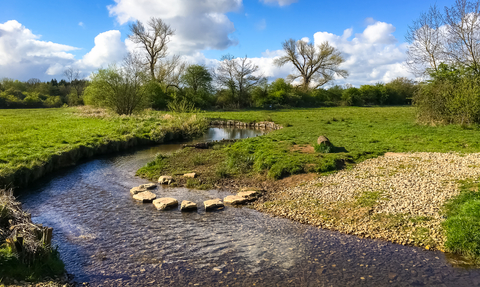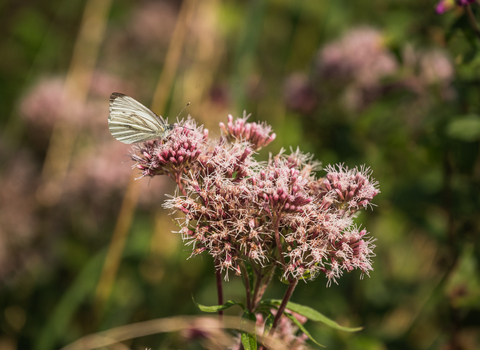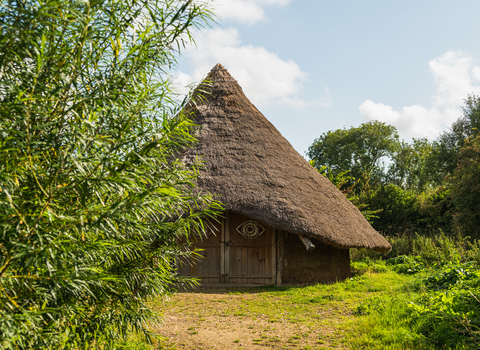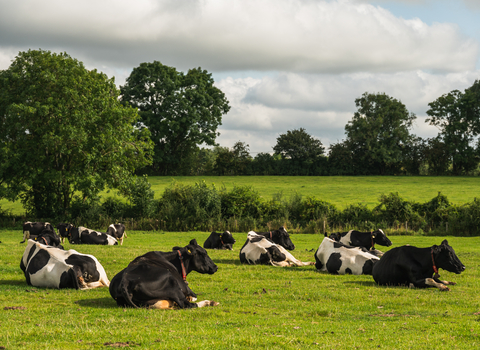
River Eye at Greystones Farm (c) Mike Boyes
About Greystones Farm
The ancient meadows and rivers of Greystones Farm are home to a diverse range of wildlife. This nature reserve is also the site of the Salmonsbury Camp, an important meeting place during Neolithic and Iron Age periods and a Scheduled Ancient Monument (SAM).
Discover more about the wildlife, archaeological finds and the history of farming at Greystones Farm below.
This reserve combines several habitats: its wildflower-rich meadows are designated a Site of Special Scientific Interest (SSSI). These ancient meadows are home to an incredible diversity of wildflowers and provide a habitat for many insects, butterflies, birds and mammals.
In the spring and summer you will see great burnet, southern marsh orchids, early marsh orchids, ragged robin, devil’s-bit scabious, meadowsweet, knapweed and yellow rattle. These flowers support butterflies including orange-tip, meadow brown, brimstone, small copper and ringlet. We are also working to restore the hay meadows which were damaged from the 1940s onwards, with the aim to bring local wildflowers back to these areas of Greystones.
The Rivers Dikler and Eye both pass through the farm and their banks support a variety of species. Listen out for water voles rustling among the dense vegetation, as well as the distinctively ‘plop’ when they enter the water. This species is severely endangered, through loss of habitat and predation by mink, but thanks to Gloucestershire Wildlife Trust, Greystones now has one of the largest populations in the Cotswolds. Stretches of riverbank have been fenced off to encourage vegetation, both for them and for the otters that regularly travel the river.
In this wonderful habitat tiny fish can be seen all year, but invertebrates like freshwater shrimps and mayfly nymphs hide away under pebbles and banks. Watch in early summer for flamboyant banded and beautiful demoiselles and for other species later. A glimpse of a kingfisher is possible!.
We’ve also created habitats and homes for bats, owls and other birds around the farm and visitor centre. Common and soprano pipistrelles, Natterer’s bats, long-eared bats and lesser horseshoe bats roost above the Discovery Barn and barn owls roost in the office building. Around the farm, swallows and house martins nest in the barn eaves and pied wagtails stalk the rooves looking for insects.
Since the end of the last Ice Age, around 10,000 years ago, the River Eye and River Dickler have run through this valley. Underlying clays kept the water table high and marshland soon formed. Layers of decaying marsh plants accumulated over millennia, gradually forming peaty black alluvial soils.
The land around Greystones Farm has been used to produce food for 6,000 years. Its once dense woodland was initially cleared by Neolithic people. Recent geophysical surveys have discovered fragmented concentric ditches which are characteristic of a Neolithic causewayed enclosure. From 6,000 to 5,500 years ago these early meeting places served several important functions, from corralling cattle to seasonal feasts and rituals associated with the dead.
3,000 years ago, during the late Iron Age, the area was farmed and well-populated, while in around 100BCE an impressive hillfort was built with double banks and ditches and a large ‘annexe’ joining the marsh. The hillfort included the Neolithic monument – perhaps of ‘ancestral’ importance. Construction of this community (perhaps more for status than defence) required massive resources.
This structure became obsolete during the seemingly peaceful takeover by the Romans after 43AD when they constructed the Fosse Way. Now levelled after 2,000 years, it is hard to visualise this formidable hillfort, though Anglo-Saxon place names and later descriptions suggest it remained for several centuries.
Part of the farm was named ‘The Moors’ by the Anglo-Saxons, suggesting it was wet in nature, and it’s thought that Evesham Abbey, which once owned the land, attempted to drain it as early as 700AD. Historians believe this meadow was enclosed as a field during the seventeenth century or just afterwards.
When preparing for the foundations of the new farm and visitor structures, several Iron Age burial pits were discovered. The skeletons and several other finds are stored in The Corinium museum in Cirencester.
Greystones Farm was purchased in three stages between 1999 and 2001 with the aim of demonstrating how farming practices and wildlife enhancement need not be exclusive endeavours.
The land around Greystones has been used for the past 6000 years to produce food. However, farming as we understand it today, could have started here in Anglo-Saxon times when an area, known as ‘The Moors’, is thought to have been cultivated.
The Anglo-Saxon name ‘The Moors’ implies an area of little value, too wet to make good meadows. However, an Anglo-Saxon first mentioned Sulmonnesburg – the ploughman’s ‘burh’, a fortified enclosure, in 779AD. Is it possible that early attempts, perhaps by wealthy Evesham Abbey (the landowners), were made to drain The Moors as early at 700AD.
It is thought most likely that the meadow was drained when it was enclosed as fields, between 1620 and 1774. Prior to this, The Berryfields (one of Bourton’s three Open Fields) were farmed in unfenced strips. On the shallow hill-fort soils, these fields would not have needed draining. The 1774 Enclosures Award Map shows the River Eye as arrow-straight and tight-angled, probably diverted at that time to accelerate drainage from new field-boundary ditches.
Gloucestershire Wildlife Trust bought the farm in 3 stages between the years 1999 and 2001 with the aim of demonstrating that farming practices and wildlife enhancement need not be exclusive endeavours.
The Trust initially joined forces with Turnstone Farming Company Ltd to establish a working dairy cattle herd at Greystones. In early 2025, the Trust realised the need to change how the reserve was managed for farming and nature to protect the current habitats and more-than-double the size of the rare and precious grassland habitats the reserve has to offer.
The plan involves re-instating the farm’s traditional beef herd to allow better control of the way cattle graze the grassland habitat in a way that the current dairy herd – dependent on regular milking and present on the site for the last 10 years or so – cannot. In light of this, Gloucestershire Wildlife Trust has recently served a 12-month notice period to Turnstone Farming Company Ltd, and is now considering a range of different options that will enable a beef herd to return to the site by the autumn of 2026.
More information on this change can be found here.



